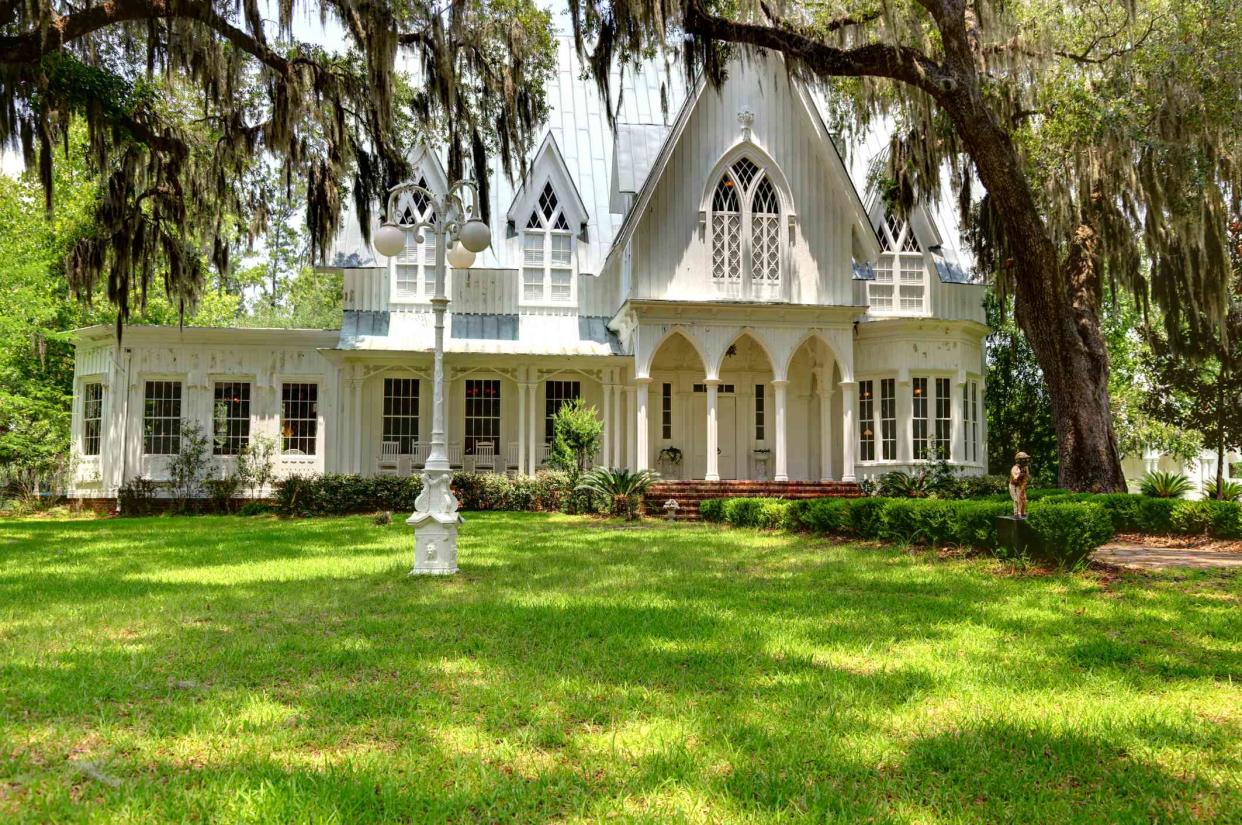What Is Gothic Revival Architecture?

akaplummer / Getty Images
Fact checked by Sarah Scott
Gothic Revival architecture, also called Neo-Gothic or Victorian Gothic, should evoke images of pointed arches and intricate detailing, like that found in Victorian-era churches or historical buildings. The Gothic Revival style primarily utilized in the 1800s also influenced residential homes and famous governmental or educational buildings.
Read on to discover what defines this fanciful architectural style, where it came from, and how to identify it.
Key Characteristics
Gothic Revival architecture is most readily identified by its intricate detailing, tall, vertical emphasis, large windows, and many pointed arches. All these features combine to create a castle-like appearance reminiscent of medieval Gothic architecture.
Intricate detailing: These structures have steep gables often trimmed with decorative trims or details.
Building materials: Gothic Revival structures were constructed of stone, glass, iron, and steel to capture the feeling of stone construction used in the 16th century and prior.
Vertical emphasis: Vertical lines and detailing add to the visual height of this architectural style. Towers are frequently built onto these structures and are topped with finials and parapets.
Flying buttresses: Flying buttresses support the soaring ceilings used in this style. This architectural term refers to a support perpendicular to the exterior wall. It connects towards the top of the wall and "flies" away to support the ground some distance from the structure.
Pointed arches: The iconic arches are seen in window shapes, doorways, and decorative features.
Large windows: These often tall, giant, pointed windows utilized stained glass to depict religious scenes or colorful imagery.
Some famous buildings in this unique style include The Houses of Parliament, Big Ben, All Souls College at the University of Oxford, and the Strawberry Hill House in England.
In the U.S., this style was used to design the Lyndhurst Mansion in New York, the Rose Hill Mansion Plantation in South Carolina, and the Oak Bluffs Carpenter Gothic cottages in Martha's Vineyard, Massachusetts.
Origins
Gothic Revival architecture emerged in the 18th century in England. At this point in history, nostalgia for medieval times flourished as industrialization began to shape the world. Society began to take a more modern view of the world, supporting the use and construction of factories and machinery.
The Gothic Revival was a love note to older times and was supported by those against this industrial shift. Gothic elements and a more traditional worldview spurred the Revival of this old-world architectural style.
By the late 19th century, new building materials and construction methods put more of an emphasis on function rather than adornment. Fancifully adorned towers and elaborate detailing were no longer the focus, and the Gothic Revival style went out of style.
Gothic Revival vs. Gothic Architecture
Because original Gothic works primarily inspire Gothic Revival architecture, the two architectural styles have very similar characteristics and defining factors.
Both are identifiable by their intricate details, towering heights, large windows and pointed arches. The main differences between Gothic architecture and Gothic Revival architecture are the periods in which they were built and the materials and building methods available.
Gothic Architecture
Built in or before the 16th century
Stone and glass
Old-world construction methods
Gothic Revival Architecture
Built in the 18th and 19th centuries
Stone, glass, iron, and steel
Newer construction methods
Gothic Revival Houses: Carpenter Gothic
The detail-heavy Gothic Revival architectural style also found its way to residential buildings, called "carpenter" Gothic Revival architecture. Carpenter Gothic brings an old-world feeling to residential buildings.
This housing style usually has fewer details than the traditional Gothic Revival. The features are scaled down and simplified when applied to homes, making them more accessible to homeowners. It includes pointed arches, doorways, and steep roofs, emphasizing verticality with vertical siding, tall, pointed windows, and intricate detailing.
Decorative or "gingerbread" trim is used around gables to give these homes a similar feeling to the highly detailed Gothic structures without covering the entire structure in ornate detailing. Parapets, towers, and finials are also sometimes added to these homes. However, the style avoided overcomplicating or adding too many heavy Gothic Revival details.
In addition, recent design trends have incorporated Gothic style or created looks like Goth cottagecore. If you love Gothic Revival architecture, try these styles out in your own space to replicate the feel of this unique architectural period.
Frequently Asked Questions
What defines Gothic Revival architecture?
Gothic Revival architecture was in style during the 18th and 19th centuries as a building style heavily influenced by medieval architecture. It was primarily used for larger buildings, such as schools, churches, and government buildings, but also found its way to houses and residential buildings.
What are the principles of Gothic Revival architecture?
The main features of the Gothic Revival style are pointed arches in windows and doors, steep roofs, detailed trim, and the use of stone and other castle-like elements.
What design characteristics define the Gothic Revival interior?
Gothic Revival interiors reflect the exteriors with ornate and somber, darkly bold decor. The styles include stained glass windows, vaulted ceilings, heavy oak furniture, and dramatic wallpaper, including floral designs or rich patterns. Heavy materials like velvet or jacquard look right at home with this style. Consider using ornate interior finishes and trim, like crown molding with flourishes. Gargoyles and angelic statuary might be just the thing, or take the style over the top.
What is the difference between Gothic Revival and Neo-Gothic?
Gothic Revival and Neo-Gothic are one and the same.
Read Next: What Is Victorian Architecture?
Read the original article on The Spruce.

